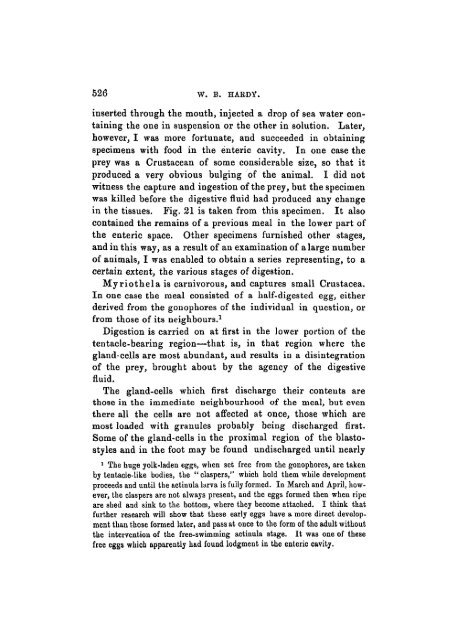supporting lamella
supporting lamella
supporting lamella
You also want an ePaper? Increase the reach of your titles
YUMPU automatically turns print PDFs into web optimized ePapers that Google loves.
526 W. B. HAEDY.<br />
inserted through the mouth, injected a drop of sea water containing<br />
the one in suspension or the other in solution. Later,<br />
however, I was more fortunate, and succeeded in obtaining<br />
specimens with food in the enteric cavity. In one case the<br />
prey was a Crustacean of some considerable size, so that it<br />
produced a very obvious bulging of the animal. I did not<br />
witness the capture and ingestion of the prey, but the specimen<br />
was killed before the digestive fluid had produced any change<br />
in the tissues. Fig. 21 is taken from this specimen. It also<br />
contained the remains of a previous meal in the lower part of<br />
the enteric space. Other specimens furnished other stages,<br />
and in this way, as a result of an examination of a large number<br />
of animals, I was enabled to obtain a series representing, to a<br />
certain extent, the various stages of digestion.<br />
Myriothela is carnivorous, and captures small Crustacea.<br />
In one case the meal consisted of a half-digested egg, either<br />
derived from the gonophores of the individual in question, or<br />
from those of its neighbours. 1<br />
Digestion is carried on at first in the lower portion of the<br />
tentacle-bearing region—that is, in that region where the<br />
gland-cells are most abundant, and results in a disintegration<br />
of the prey, brought about by the agency of the digestive<br />
fluid.<br />
The gland-cells which first discharge their contents are<br />
those in the immediate neighbourhood of the meal, but even<br />
there all the cells are not affected at once, those which are<br />
most loaded with granules probably being discharged first.<br />
Some of the gland-cells in the proximal region of the blastostyles<br />
and in the foot may be found undischarged until nearly<br />
1<br />
The huge yolk-laden eggs, when set free from the gonophores, are taken<br />
by tentacle-like bodies, the "claspers," which hold them while development<br />
proceeds and until the actinula larva is fully formed. In March and April, however,<br />
the claspers are not always present, and the eggs formed then when ripe<br />
are shed and sink to the bottom, where they become attached. I think that<br />
further research will show that these early eggs have a more direct development<br />
than those formed later, and pass at once to the form of the adult without<br />
the intervention of the free-swimming actinula stage. It was one of these<br />
free eggs which apparently had found lodgment in the enteric cavity.

















